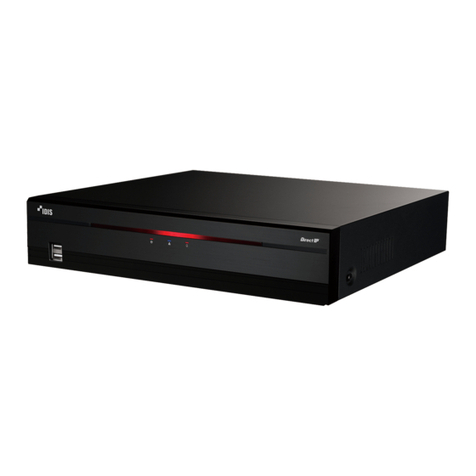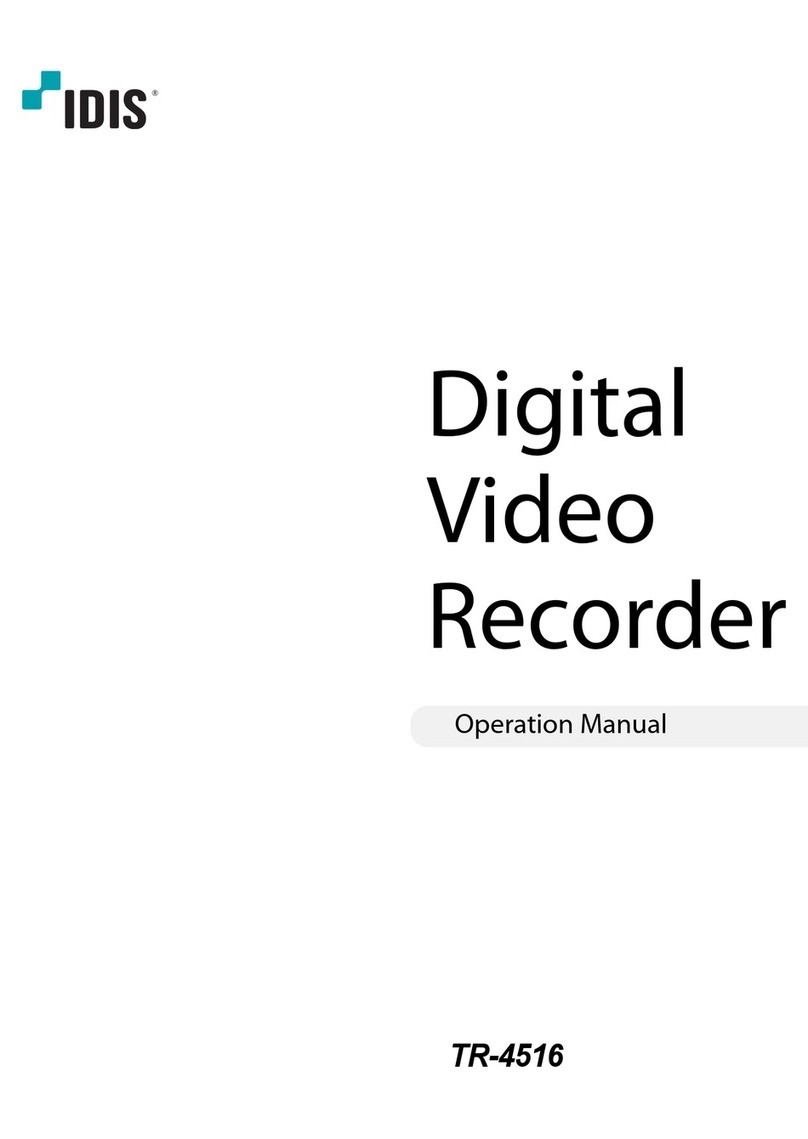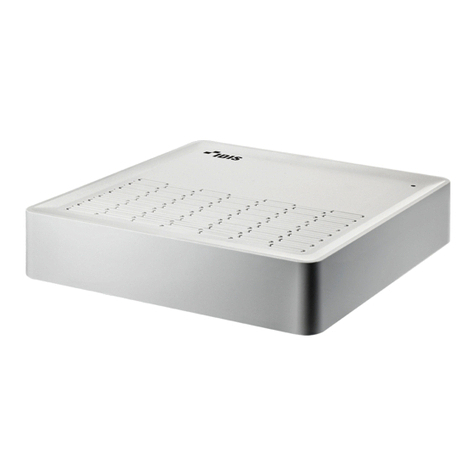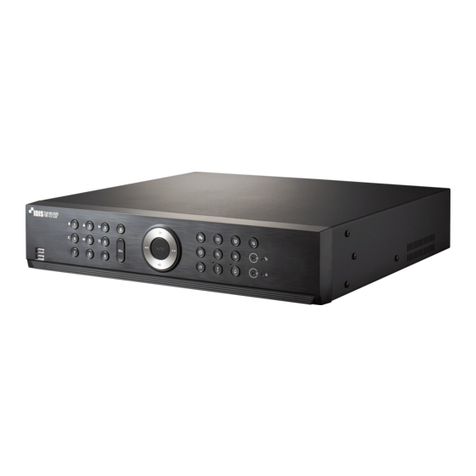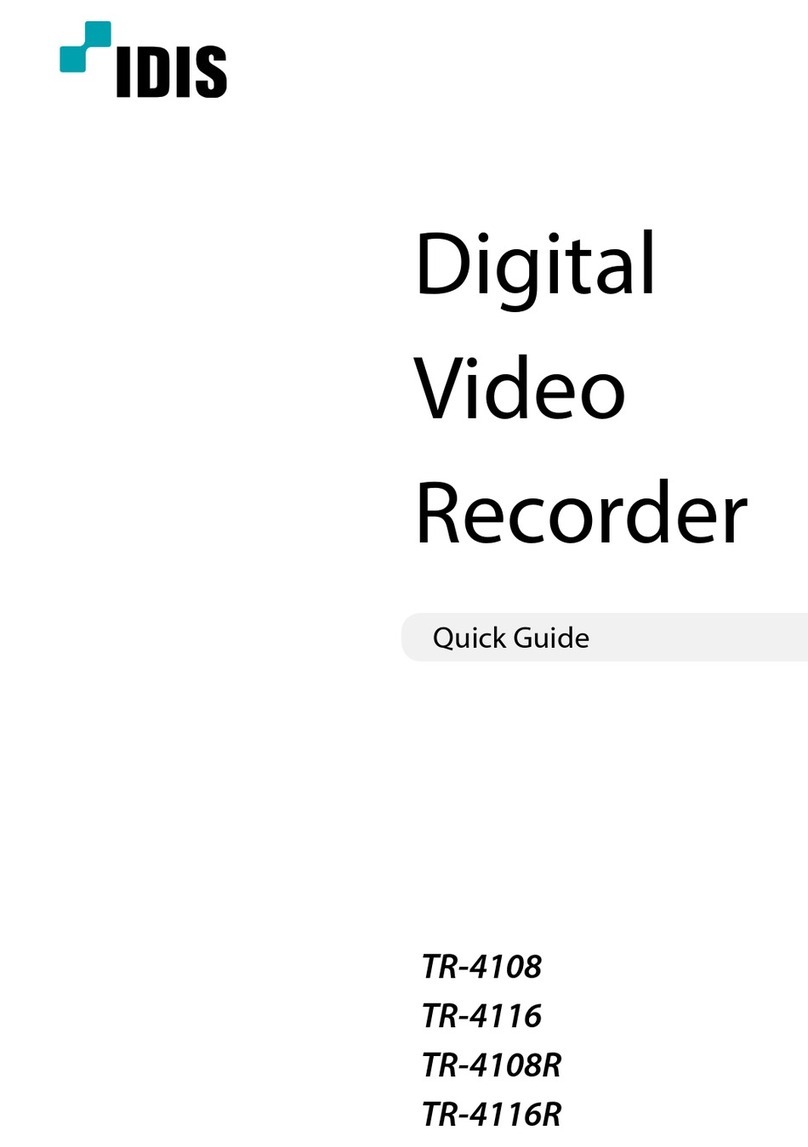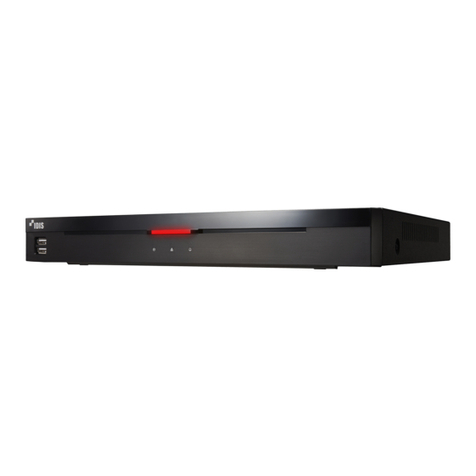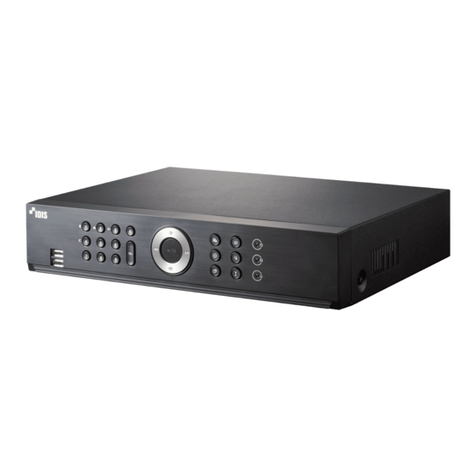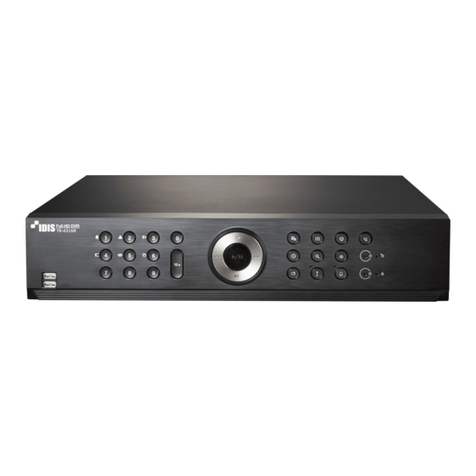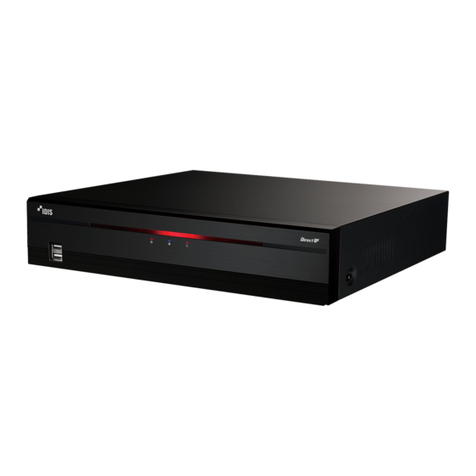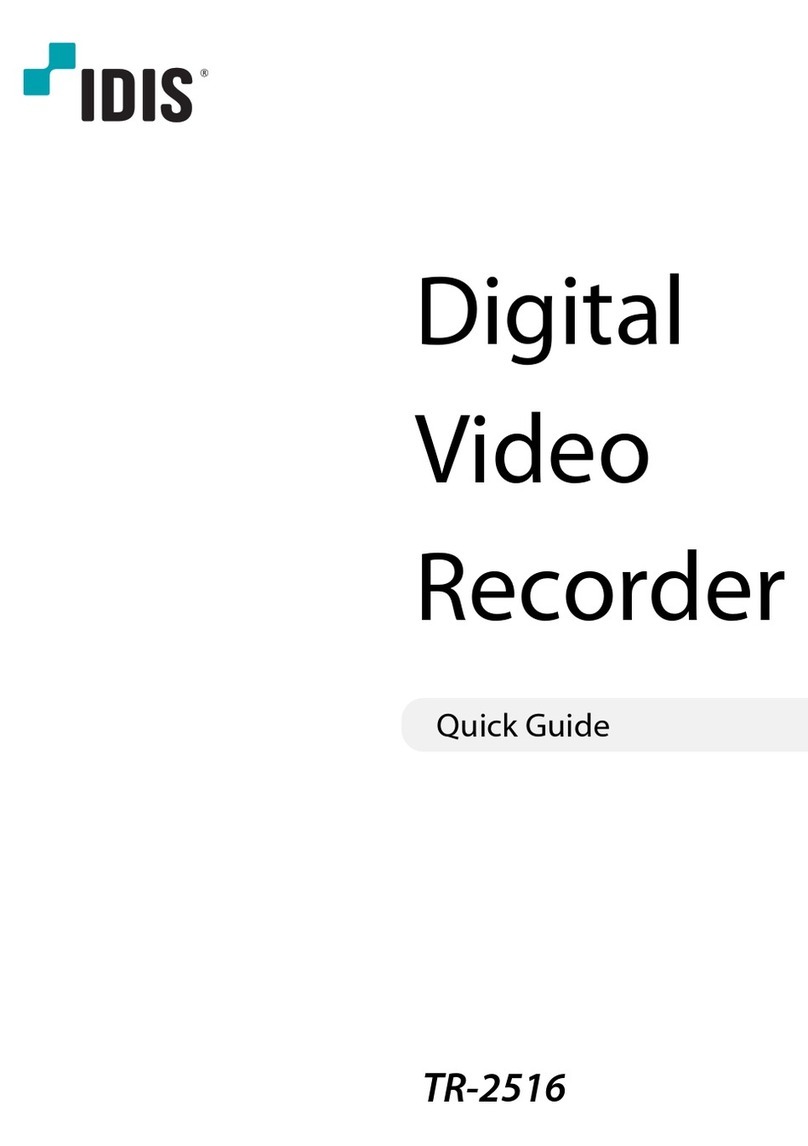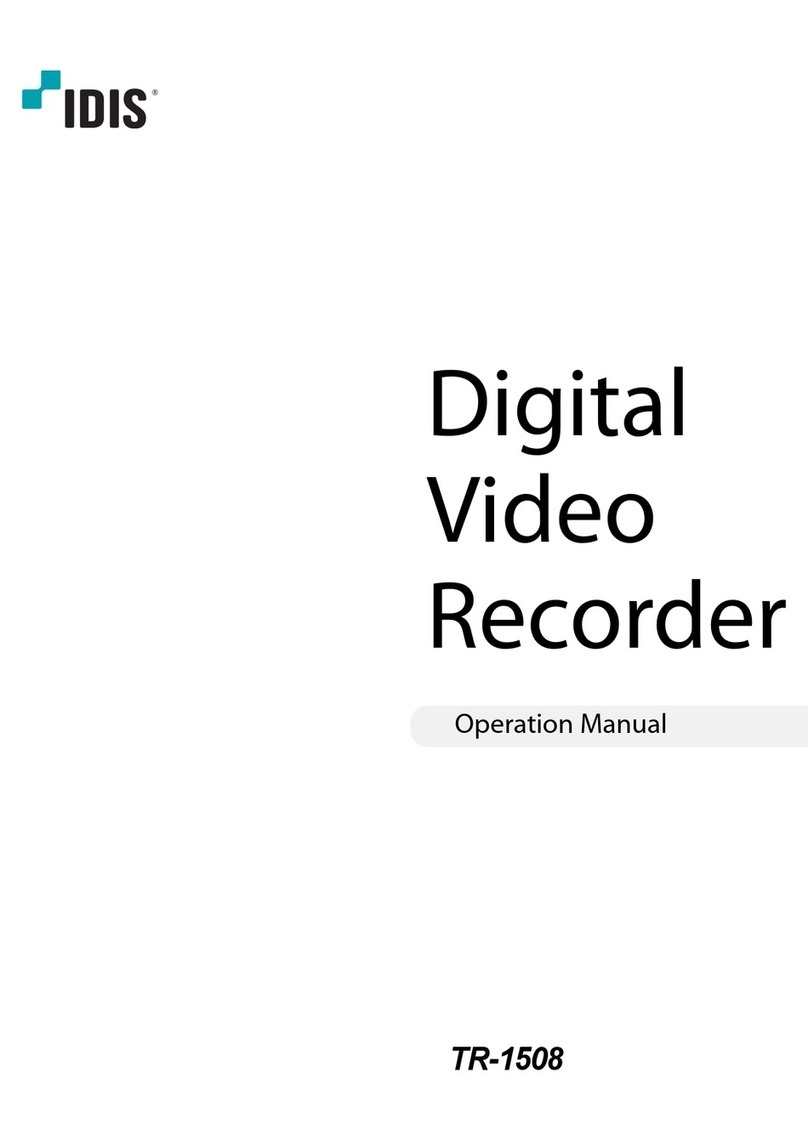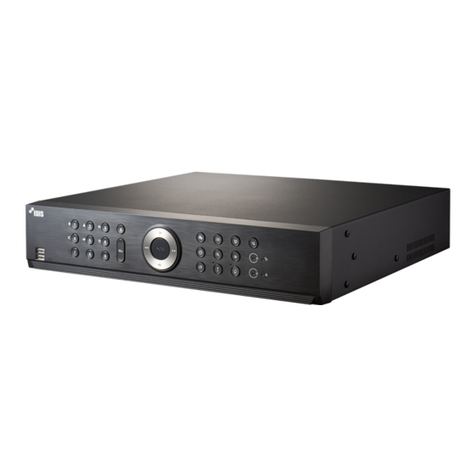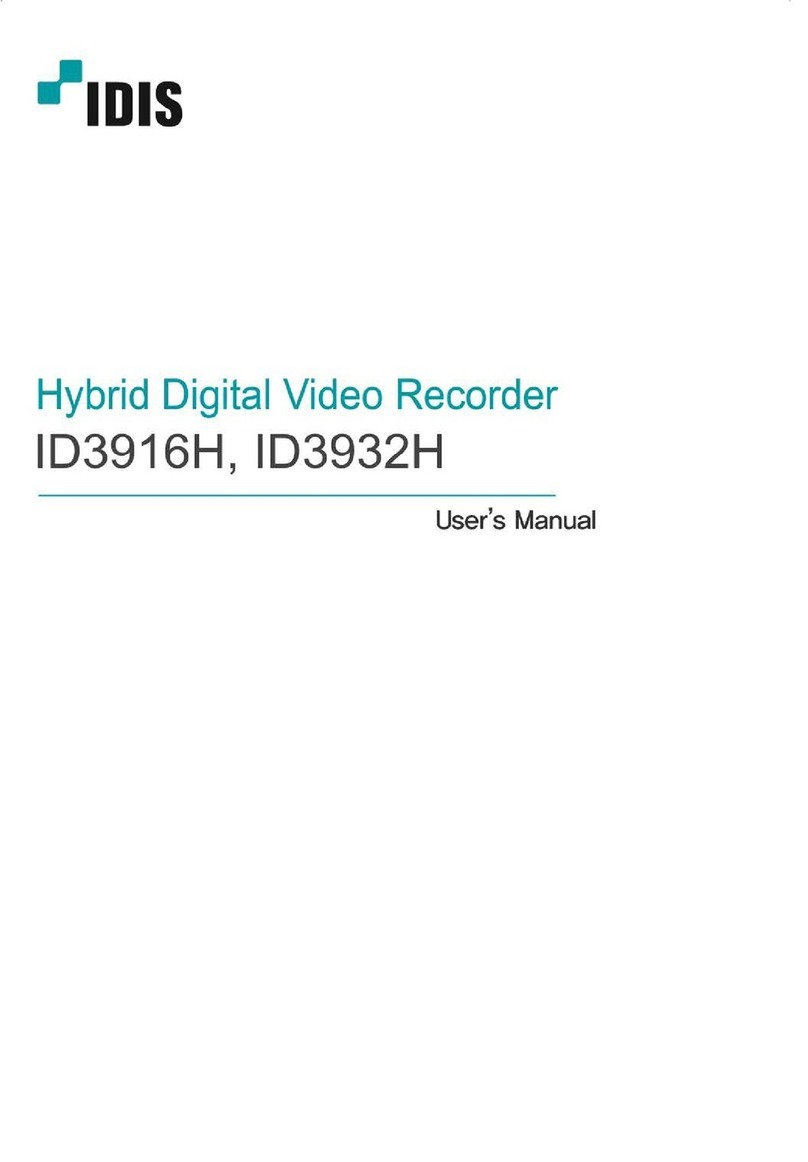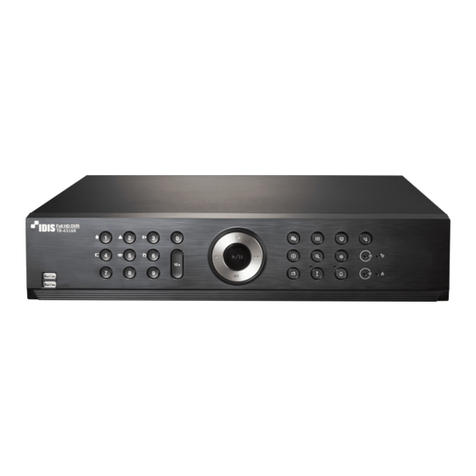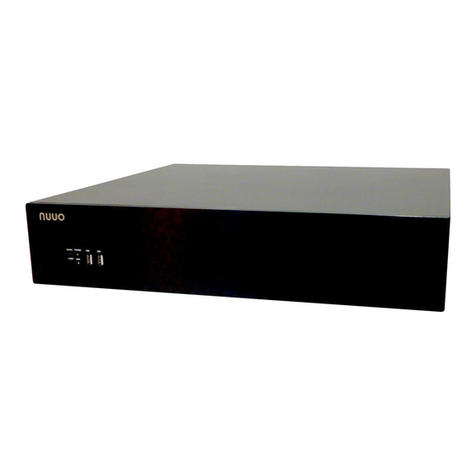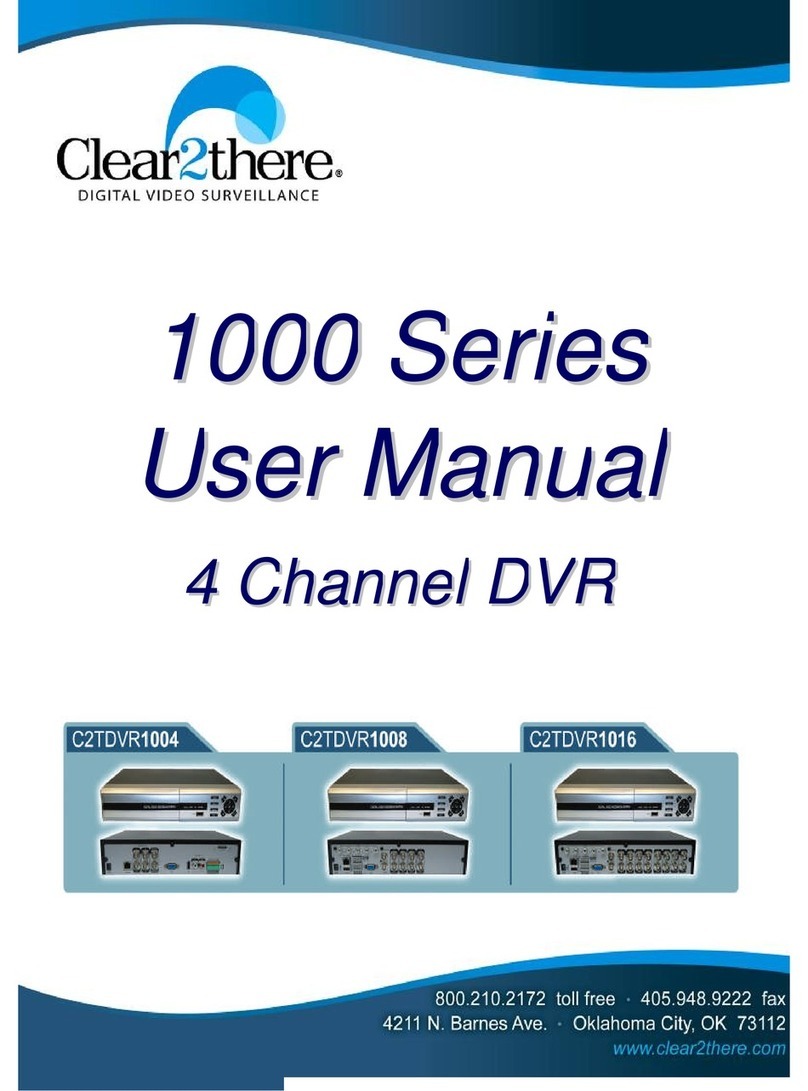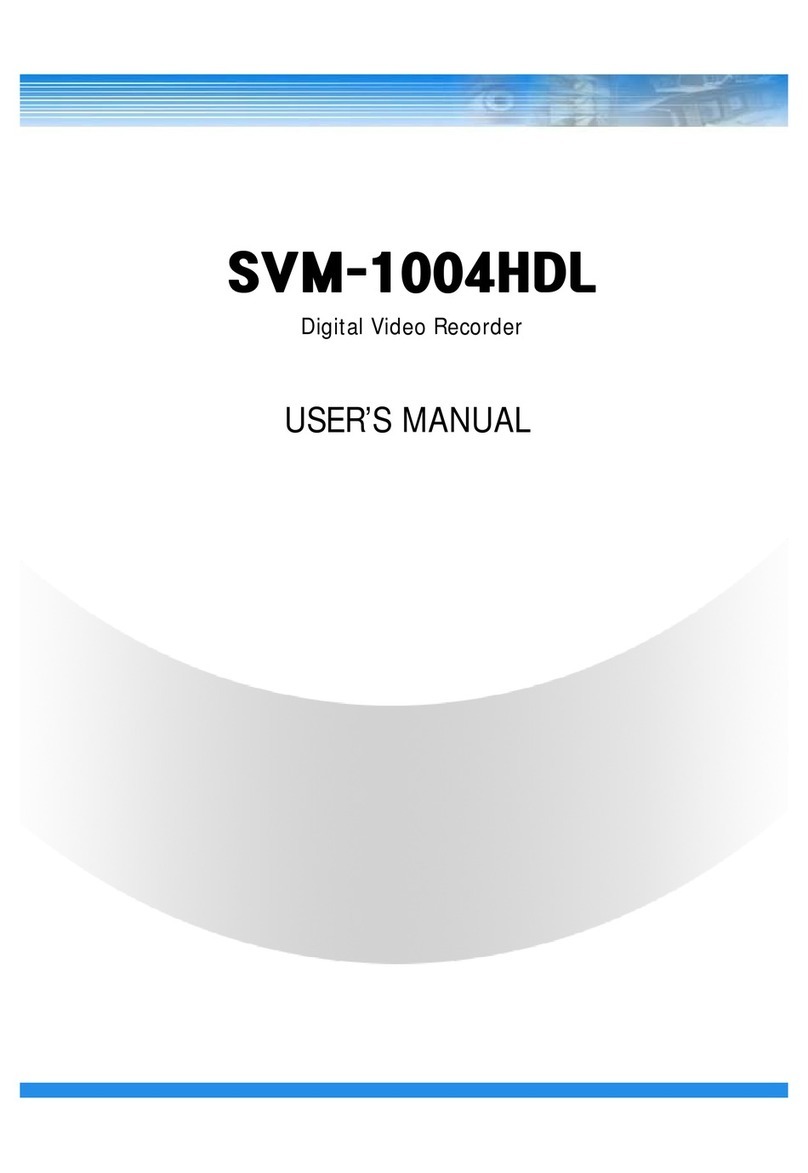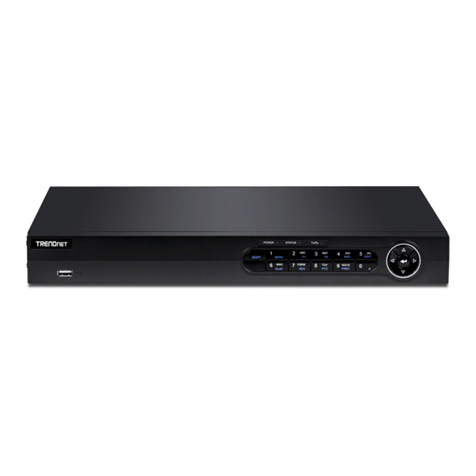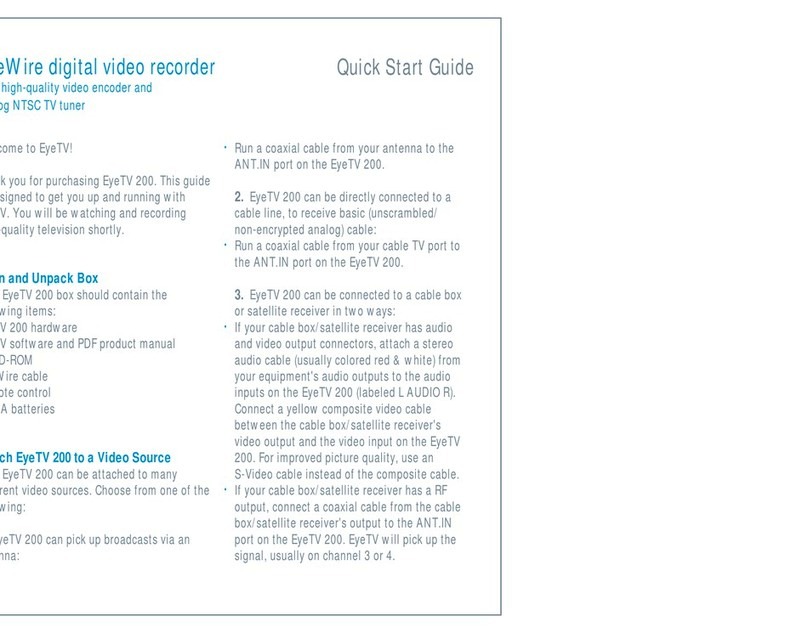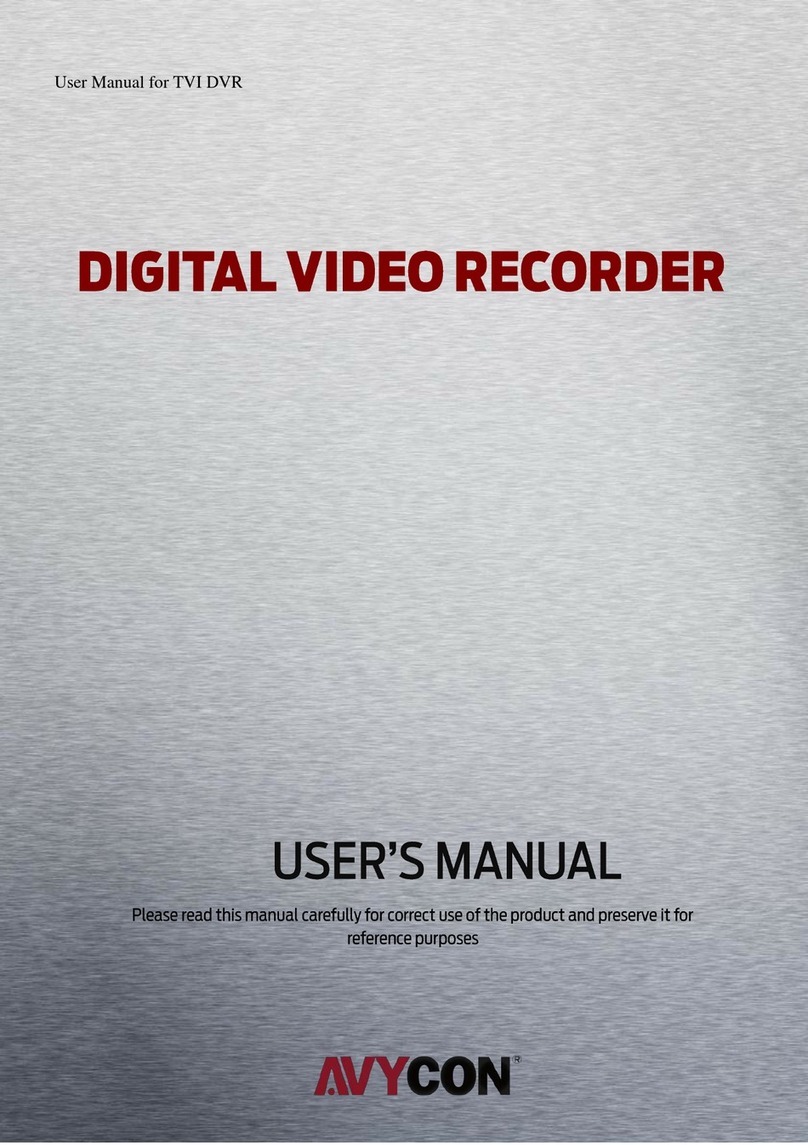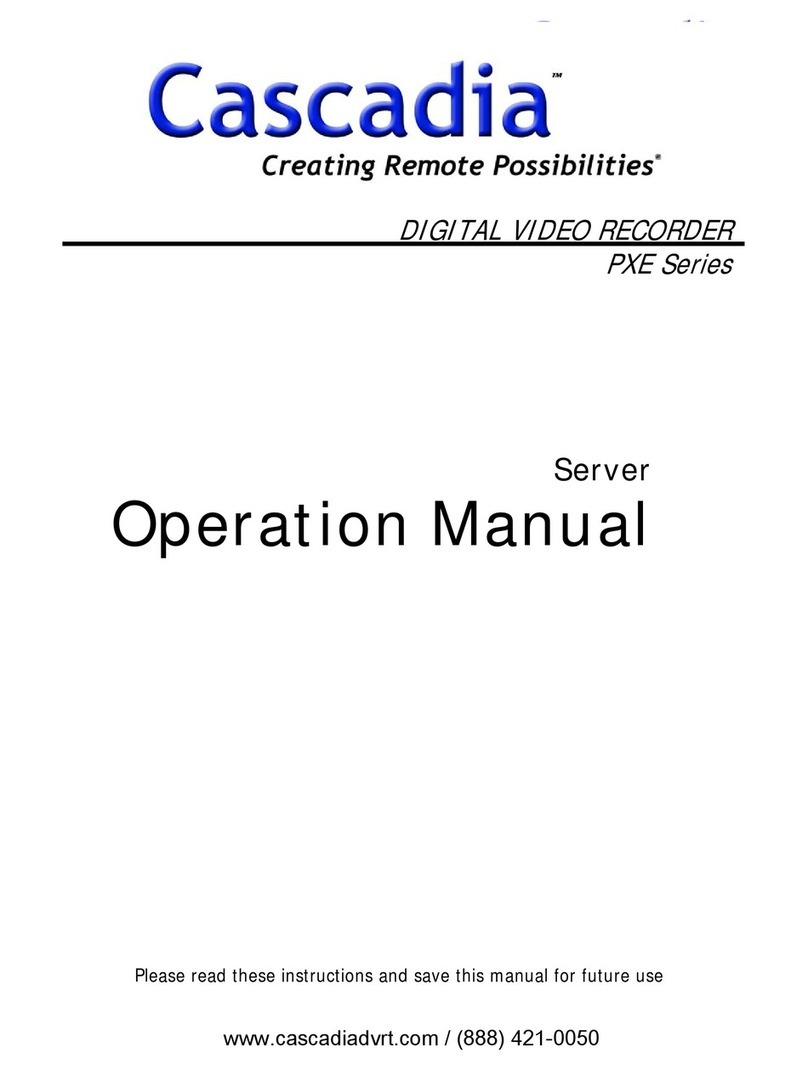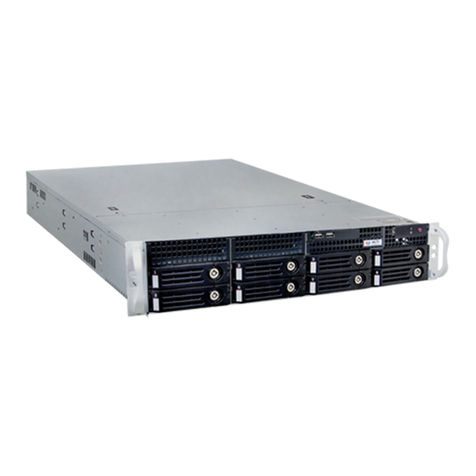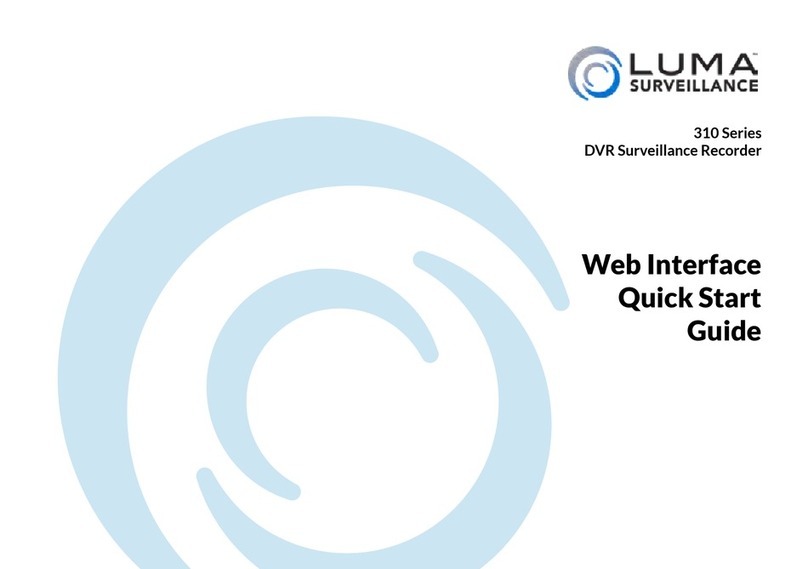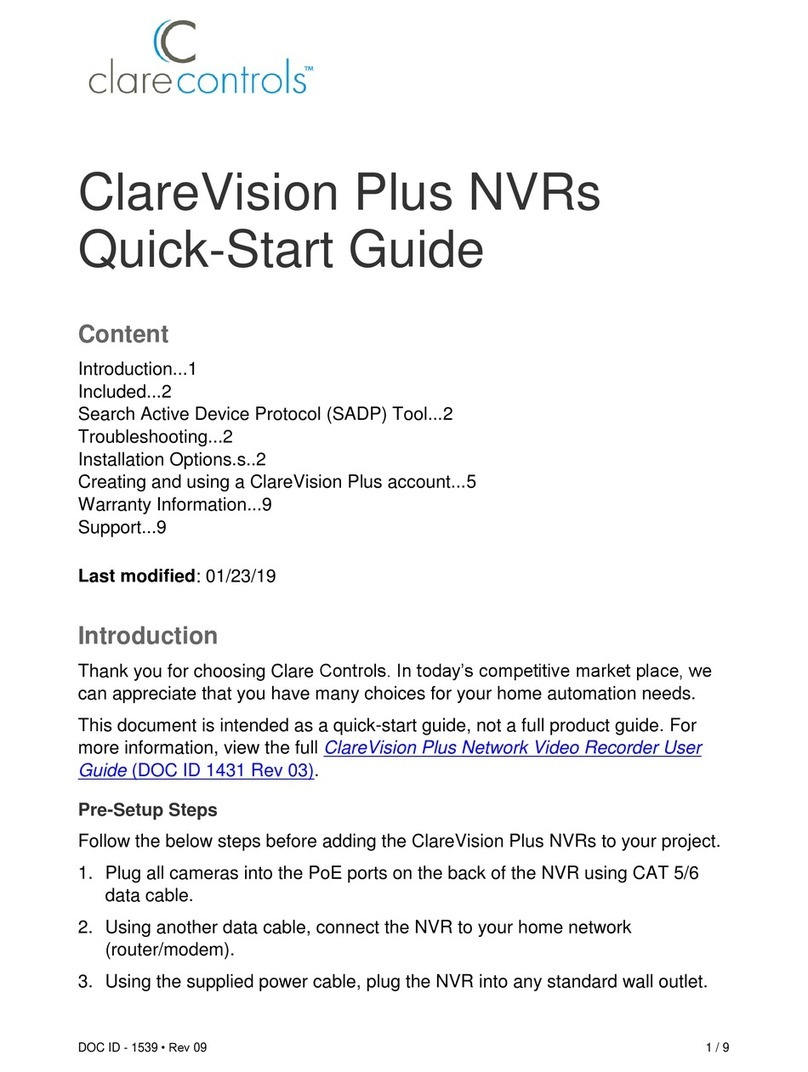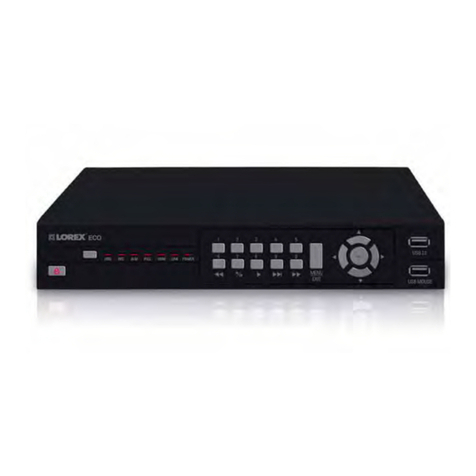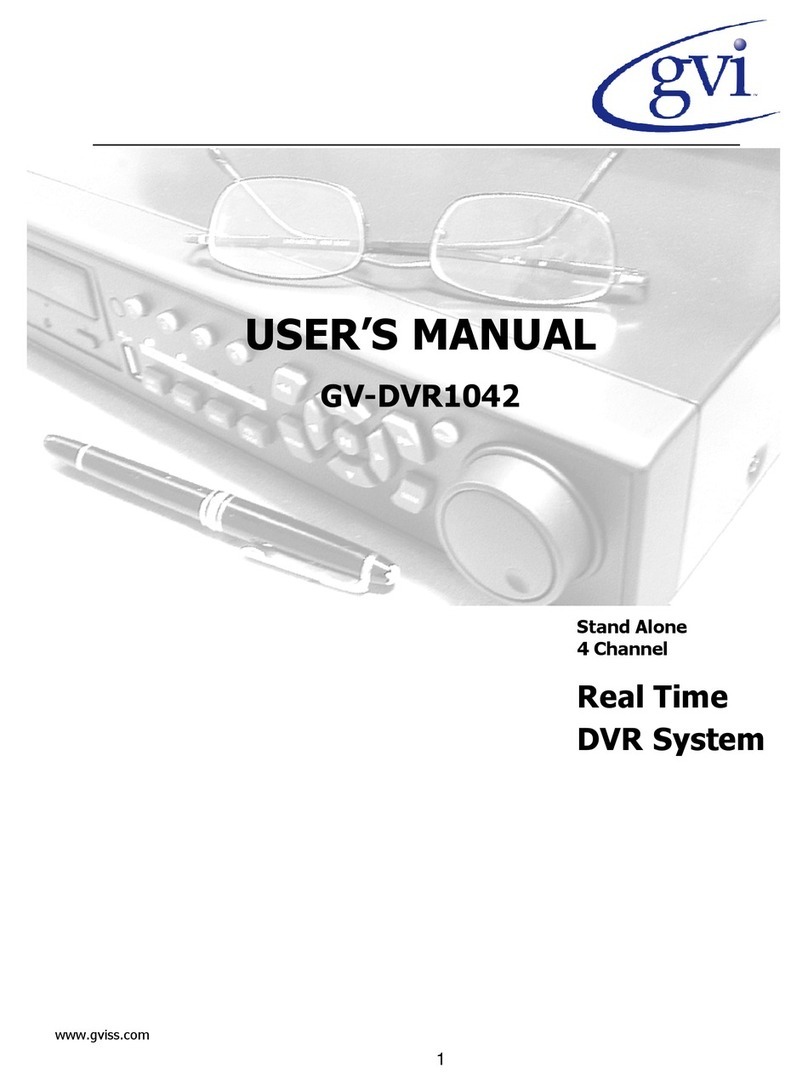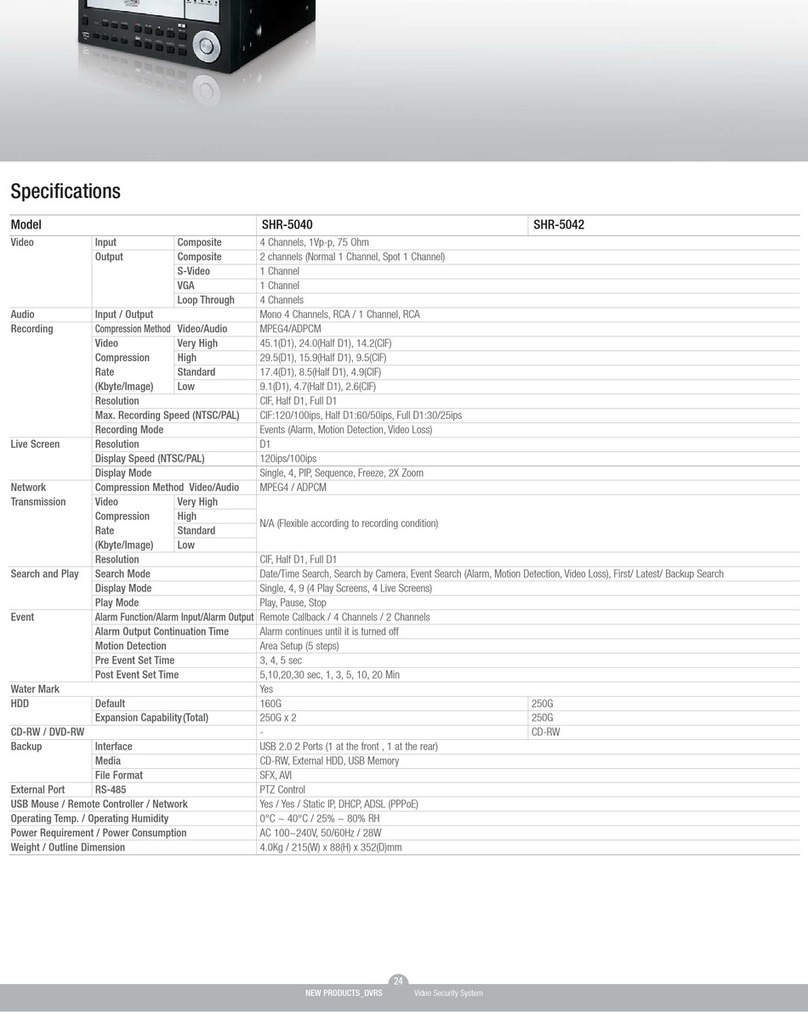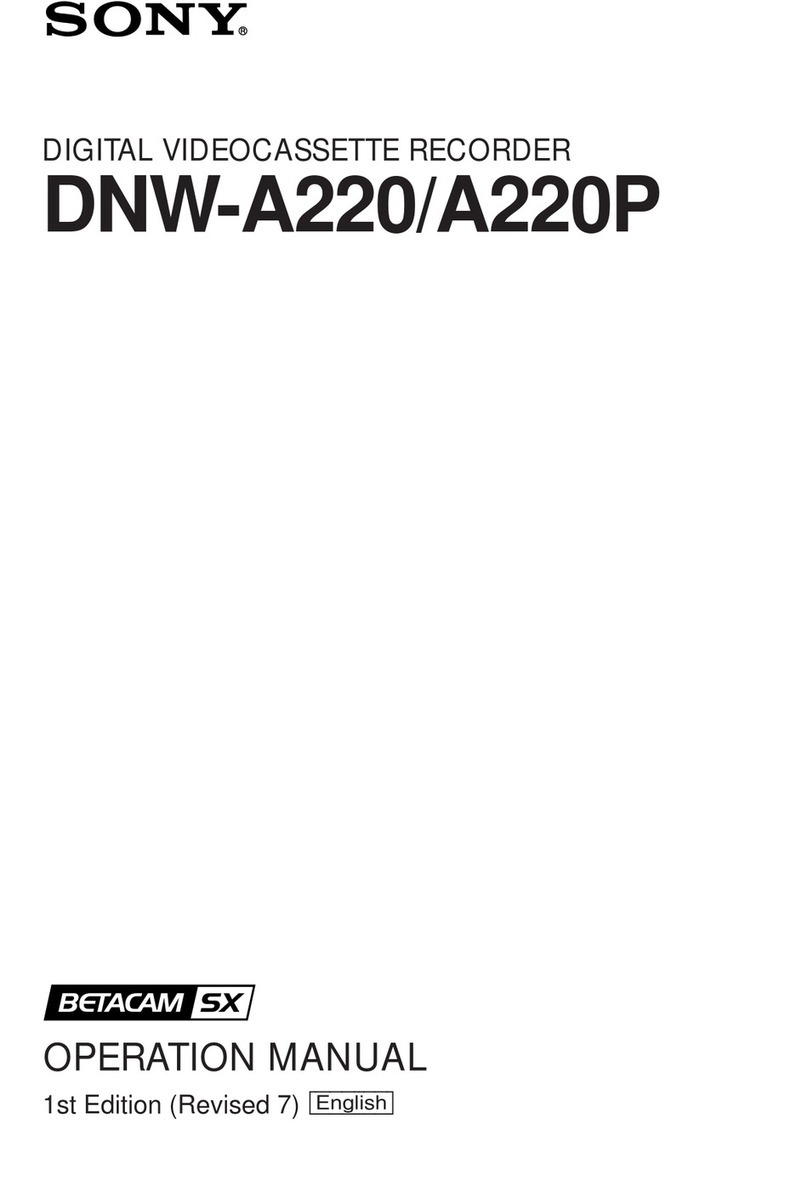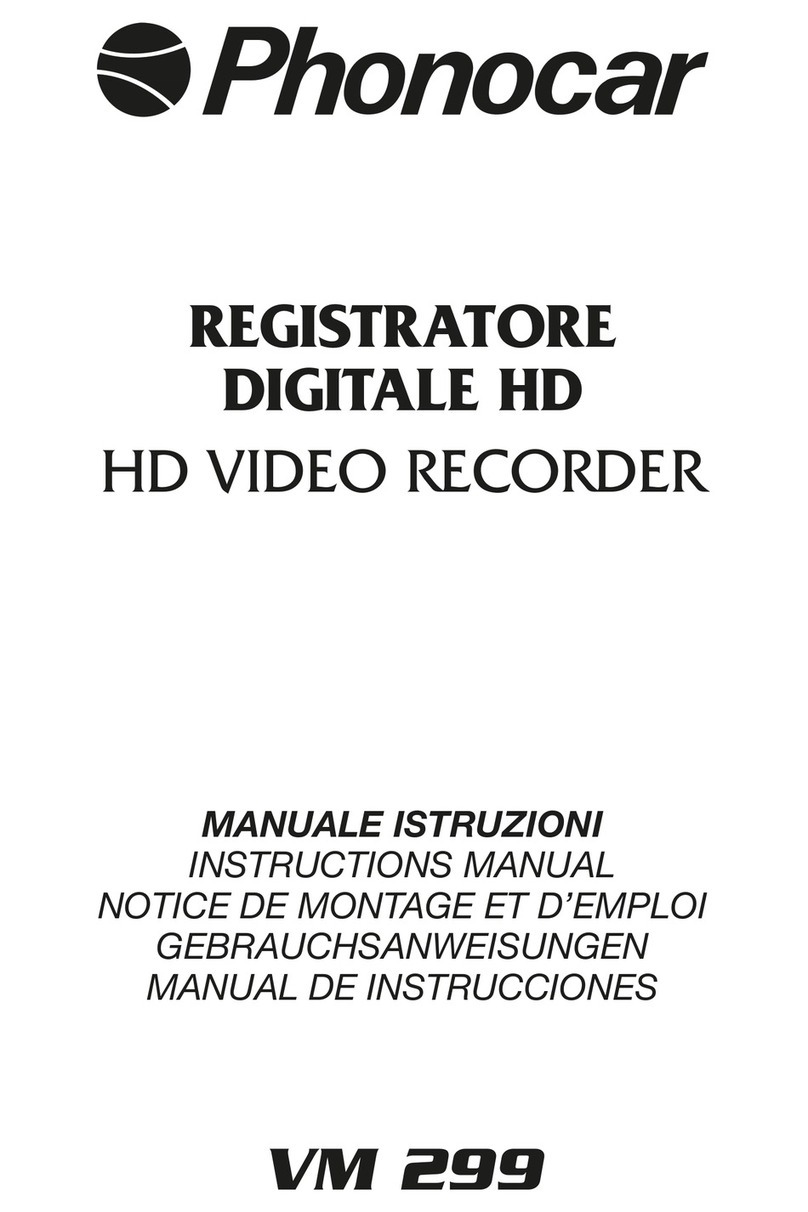Idis TR-2416 User manual

Digital
Video
Recorder
Installation Manual
TR-2416

2
Before reading this manual
This manual contains basic instructions on installing and using Digital Video Recorder, an IDIS product.
Users who are using this product for the rst time, as well as users with experience using comparable products,
must read this manual carefully before use and heed to the warnings and precautions contained herein while using
the product. Safety warnings and precautions contained in this manual are intended to promote proper use of the
product and thereby prevent accidents and property damage and must be followed at all times.
Once you have read this manual, keep it at an easily accessible location for future reference.
• The manufacturer will not be held responsible for any product damage resulting from the use of unauthorized parts and
accessories or from the user's failure to comply with the instructions contained in this manual.
• It is recommended that rst-time users of Digital Video Recorder and individuals who are not familiar with its use seek
technical assistance from their retailer regarding product installation and use.
• If you need to disassemble the product for functionality expansion or repair purposes, you must contact your retailer and
seek professional assistance.
• Both retailers and users should be aware that this product has been certied as being electromagnetically compatible for
commercial use. If you have sold or purchased this product unintentionally, please replace with a consumer version.
Safety Precautions
CAUTION
RISK OF ELECTRIC SHOCK
DO NOT OPEN
CAUTION: TO REDUCE THE RISK OF ELECTRIC SHOCK,
DO NOT REMOVE COVER (OR BACK).
NO USER-SERVICEABLE PARTS INSIDE.
REFER SERVICING TO QUALIFIED SERVICE PERSONNEL.
The lightning ash with arrowhead symbol, within an equilateral triangle, is intended to alert the user to the
presence of uninsulated "dangerous voltage" within the product’s enclosure that may be of sucient magnitude to
constitute a risk of electric shock.
The exclamation point within an equilateral triangle is intended to alert the user to the presence of important
operating and maintenance (servicing) instructions in the literature accompanying the appliance.
Symbol Publication Description
IEC60417, No.5032 Alternating current
IEC60417, No.5031 Direct current

Before reading this manual
3
Important Safeguards
1. Read Instructions
All the safety and operating instructions should be read before the appliance
is operated.
2. Retain Instructions
The safety and operating instructions should be retained for future reference.
3. Cleaning
Unplug this equipment from the wall outlet before cleaning it. Do not use
liquid aerosol cleaners. Use a damp soft cloth for cleaning.
4. Attachments
Never add any attachments and/or equipment without the approval of the
manufacturer as such additions may result in the risk of re, electric shock or
other personal injury.
5. Water and/or Moisture
Do not use this equipment near water or in contact with water.
6. Ventilation
Place this equipment only in an upright position. This equipment has an
open-frame Switching Mode Power Supply (SMPS), which can cause a re or
electric shock if anything is inserted through the ventilation holes on the side
of the equipment.
7. Accessories
Do not place this equipment on an unstable cart, stand or table. The
equipment may fall, causing serious injury to a child or adult, and serious
damage to the equipment. Wall or shelf mounting should follow the
manufacturer's instructions, and should use a mounting kit approved by the
manufacturer.
This equipment and cart combination should be moved with care. Quick
stops, excessive force, and uneven surfaces may cause the equipment and cart
combination to overturn.
8. Power Sources
This equipment should be operated only from the type of power source
indicated on the marking label. If you are not sure of the type of power, please
consult your equipment dealer or local power company.
You may want to install a UPS (Uninterruptible Power Supply) system for
safe operation in order to prevent damage caused by an unexpected power
stoppage. Any questions concerning UPS, consult your UPS retailer.
9. Power Cords
Operator or installer must remove power and TNT connections before
handling the equipment.
10. Lightning
For added protection for this equipment during a lightning storm, or when it
is left unattended and unused for long periods of time, unplug it from the wall
outlet and disconnect the antenna or cable system. This will prevent damage
to the equipment due to lightning and power-line surges.
11. Overloading
Do not overload wall outlets and extension cords as this can result in the risk
of re or electric shock.
12. Objects and Liquids
Never push objects of any kind through openings of this equipment as they
may touch dangerous voltage points or short out parts that could result in a
re or electric shock. Never spill liquid of any kind on the equipment.
13. Servicing
Do not attempt to service this equipment yourself. Refer all servicing to
qualied service personnel.
14. Damage requiring Service
Unplug this equipment from the wall outlet and refer servicing to qualied
service personnel under the following conditions:
A. When the power-supply cord or the plug has been damaged.
B. If liquid is spilled, or objects have fallen into the equipment.
C. If the equipment has been exposed to rain or water.
D. If the equipment does not operate normally by following the operating
instructions, adjust only those controls that are covered by the operating
instructions as an improper adjustment of other controls may result in
damage and will often require extensive work by a qualied technician to
restore the equipment to its normal operation.
E. If the equipment has been dropped, or the cabinet damaged.
F. When the equipment exhibits a distinct change in performance ─ this
indicates a need for service.
15. Replacement Parts
When replacement parts are required, be sure the service technician has
used replacement parts specied by the manufacturer or that have the same
characteristics as the original part. Unauthorized substitutions may result in
re, electric shock or other hazards.
16. Safety Check
Upon completion of any service or repairs to this equipment, ask the service
technician to perform safety checks to determine that the equipment is in
proper operating condition.
17. Field Installation
This installation should be made by a qualied service person and should
conform to all local codes.
18. Correct Batteries
Warning: Risk of explosion if battery is replaced by an incorrect type. Dispose
of used batteries according to the instructions.
19. Tmra
A manufacturer’s maximum recommended ambient temperature (Tmra)
for the equipment must be specied so that the customer and installer may
determine a suitable maximum operating environment for the equipment.
20. Elevated Operating Ambient Temperature
If installed in a closed or multi-unit rack assembly, the operating ambient
temperature of the rack environment may be greater than room ambient.
Therefore, consideration should be given to installing the equipment in an
environment compatible with the manufacturer’s maximum rated ambient
temperature (Tmra).
21. Reduced Air Flow
Installation of the equipment in the rack should be such that the amount of
airow required for safe operation of the equipment is not compromised.
22. Mechanical Loading
Mounting of the equipment in the rack should be such that a hazardous
condition is not caused by uneven mechanical loading.
23. Circuit Overloading
Consideration should be given to connection of the equipment to supply
circuit and the eect that overloading of circuits might have on over current
protection and supply wiring. Appropriate consideration of equipment
nameplate ratings should be used when addressing this concern.
24. Reliable Earthing (Grounding)
Reliable grounding of rack mounted equipment should be maintained.
Particular attention should be given to supply connections other than direct
connections to the branch circuit (e.g., use of power strips).

Before reading this manual
4
In-Text
Symbol Type Description
Caution Important information concerning a specic function.
Note Useful information concerning a specic function.
User’s Caution Statement
Caution: Any changes or modications to the equipment not expressly approved by the party responsible for
compliance could void your authority to operate the equipment.
FCC Compliance Statement
THIS EQUIPMENT HAS BEEN TESTED AND FOUND TO COMPLY WITH THE LIMITS FOR A CLASS A DIGITAL DEVICE, PURSUANT TO PART
15 OF THE FCC RULES. THESE LIMITS ARE DESIGNED TO PROVIDE REASONABLE PROTECTION AGAINST HARMFUL INTERFERENCE
WHEN THE EQUIPMENT IS OPERATED IN A COMMERCIAL ENVIRONMENT. THIS EQUIPMENT GENERATES, USES, AND CAN RADIATE
RADIO FREQUENCY ENERGY AND IF NOT INSTALLED AND USED IN ACCORDANCE WITH THE INSTRUCTION MANUAL, MAY CAUSE
HARMFUL INTERFERENCE TO RADIO COMMUNICATIONS. OPERATION OF THIS EQUIPMENT IN A RESIDENTIAL AREA IS LIKELY TO
CAUSE HARMFUL INTERFERENCE, IN WHICH CASE USERS WILL BE REQUIRED TO CORRECT THE INTERFERENCE AT THEIR OWN EXPENSE.
WARNING: CHANGES OR MODIFICATIONS NOT EXPRESSLY APPROVED BY THE PARTY RESPONSIBLE FOR COMPLIANCE COULD VOID
THE USER’S AUTHORITY TO OPERATE THE EQUIPMENT.
THIS CLASS OF DIGITAL APPARATUS MEETS ALL REQUIREMENTS OF THE CANADIAN INTERFERENCE CAUSING EQUIPMENT
REGULATIONS.
WEEE (Waste Electrical & Electronic Equipment)
Correct Disposal of This Product
(Applicable in the European Union and other European countries with separate collection systems)
This marking shown on the product or its literature, indicates that it should not be disposed with other household
wastes at the end of its working life. To prevent possible harm to the environment or human health from
uncontrolled waste disposal, please separate this from other types of wastes and recycle it responsibly to promote
the sustainable reuse of material resources.
Household users should contact either the retailer where they purchased this product, or their local government
oce, for details of where and how they can take this item for environmentally safe recycling.
Business users should contact their supplier and check the terms and conditions of the purchase contract. This
product should not be mixed with other commercial wastes for disposal.

Before reading this manual
5
Copyright
© 2021 IDIS Co., Ltd.
IDIS Co., Ltd. reserves all rights concerning this manual.
Use or duplication of this manual in part or whole without the prior consent of IDIS Co., Ltd. is strictly prohibited.
Contents of this manual are subject to change without prior notice.
Registered Trademarks
IDIS is a registered trademark of IDIS Co., Ltd.
Other company and product names are registered trademarks of their respective owners.
The information in this manual is believed to be accurate as of the date of publication even though explanations of some
functions may not be included. We are not responsible for any problems resulting from the use thereof. The information
contained herein is subject to change without notice. Revisions or new editions to this publication may be issued to incorporate
such changes.
The software included in this product contains some Open Sources. You may obtain the corresponding source code which we
have to distribute according to the license policy. Go to System Setup - About page for more information. This product includes
software developed by the University of California, Berkeley and its contributors, and software developed by the OpenSSL Project
for use in the OpenSSL Toolkit (http://www.openssl.org/). Also, this product includes cryptographic software written by Eric
Young (eay@cryptsoft.com), and software written by Tim Hudson (tjh@cryptsoft.com).

6
Table of Contents
1
2
Part 1 – Introduction.........................................7
Product Features ................................................................7
Accessories. . . . . . . . . . . . . . . . . . . . . . . . . . . . . . . . . . . . . . . . . . . . . . . . . . . . . . . . . . . . . . . . . . . . . . 8
Overview .......................................................................9
Front Panel................................................................................9
Rear Panel ...............................................................................11
Rear Panel Connections ..................................................................12
Remote Control ..........................................................................16
Part 2 - Appendix ...........................................18
System Log Types ..............................................................18
Error Code Types ...............................................................19
Troubleshooting ...............................................................20
Specications ..................................................................21

7
Product Features
This is a video recorder that supports surveillance, recording, and playback of video from analog cameras.
This DVR (Digital Video Recorder) unit oers the following features:
●Real-time channels surveillance
●Compatible with Color (NTSC or PAL) and B&W (CCIR and EIA-170) Video Sources
●H.265 Codec
●Real-time 480ips video recording (standard for Full HD resolution)
●Auto Detection for HD-TVI, AHD, NTSC and PAL/Auto Detection for FHD, 3MP, 4MP and 5MP / Camera Auto
Detection for HD and SD
●HDMI out (1) and VGA out (1) ports at the same time
●UTC for camera menu control (controls camera menu using coax cable)
●Fast and easy search feature (Time-Lapse, Event log, Motion, Text-In)
●Simultaneously survey, record, play back, and transmit data in real-time
●Graphic User Interface(GUI) and multilingual
●Multiple recording modes (Schedule, Event, Pre-Event, and Panic)
●Continuous Recording in Disk Overwrite Mode
●Two USB 2.0 ports (for connecting peripherals, upgrading software, and saving recording data)
●Text Input for ATM and POS
●Two-way audio communication
●4-channel audio recording and 1-channel audio playback
●4 alarm ins, 1 alarm out, and Built-in Alarm Buzzer
●IR remote control-enabled
●Automated system event alerts (industry standard S.M.A.R.T. protocol for HDD status alerts)
iRAS
WebGuard
ATM/POS
Audio input (1~4)
Cameras (1~16)
HDMI Monitor VGA Monitor
USB HDD
Sensors (1~4)
Flash Drive
Flashing Light
Siren
Alarm Output
Network
MouseRemote Keyboard
Digital Video Recorder
IR Remote Control
Audio Output
Part 1 – Introduction

Part 1 – Introduction
8
Accessories
Upon unpackaging the product, check the contents inside to ensure that all the following accessories are included.
Digital Video Recorder Power Adapter/Power Cable Quick Guide
Optical USB Mouse IR Remote Control

Part 1 – Introduction
9
Overview
Front Panel
1
2
1HDD/Network/Alarm LEDs 2USB Ports
•Remote control sensor is located on the middle of the front panel. Ensure that the sensor remains unobstructed at all
times. If obstructed, the sensor might not be able to receive remote control signals.
•Placing a Wi-Fi, Bluetooth, or any other wireless communication device near the DVR may interfere with remote control
signal transmission.
•Access various windows and menus using a USB mouse as you would on a personal computer.
•For easier system conguration, a USB mouse is recommended.

Part 1 – Introduction
10
1LEDs
●HDD LED: Lights up when data is being written
on the HDD or a video search is in progress.
●Network LED: Lights up when the device is
connected to network through ethernet.
●Alarm LED: Lights up in red when an alarm
event occurs.
2USB Ports
●Storage Device Connection
Connect an external USB hard drive or a USB ash
memory device to one of the USB ports for use with
the Clip Copy feature. The external storage device
should be placed as close to the DVR as possible.
It is recommended that you use a connection
cable that is no longer than 180cm in length. Use
the connection cable included with your external
storage device to connect the device to one of DVR's
USB ports. For more information Clip Copy, refer to
the Clip Copy in the operation manual.
●Peripheral Device Connection
Use the USB ports to connect peripherals such as a
USB mouse to the DVR. You can also use a USB-to-
serial converter and connect multiple text-in devices
to the DVR at the same time.
For USB ash memory devices, the DVR supports
the FAT32 le format only.

Part 1 – Introduction
11
Connections on the Front Panel
Flash Memory
Mouse
USB HDD
IR Remote Control
Rear Panel
12
3
4567
8
9
6
1Video Input 2Audio In / Out 3VGA Out Port 4HDMI Out Port
5Network Port 6Alarm Connection Ports 7RS-485 Port 8RS-232 Port
9Power In Port

Part 1 – Introduction
12
Rear Panel Connections
Video Connection
Video Input
Connect the coaxial cables from the video sources to the
composite Video In connectors or BNC connectors.
Audio Connection
Connect the audio device to the AUDIO IN port and
speakers with a built-in amplier to the AUDIO OUT port.
Use the AUDIO OUT port to listen to audio from analog
cameras.
Use the AUDIO IN port to establish two-way
communication with cameras.
•This DVR does not feature a built-in audio amplier
unit and therefore requires the user to purchase a
speaker system with a built-in amplier separately.
It's possible to connect an amplied audio source to
the DVR, but microphones that do not have a built-
in amplier will not function properly if connected
to the DVR directly. If this is the case, connect the
microphone to the DVR via a pre-amp.
•Check your local laws and regulations on making
audio recordings.
Monitor Connection
Connect to the VGA OUT or HDMI port.
Network Connection
This DVR is capable of connecting to networks via the
10Mb/100Mb/1Gb ethernet connector. Connect an RJ-45
cable (Cat5e) to the DVR's network port. It's possible to
operate and upgrade the DVR remotely over a network.
For more information on ethernet connection setup, refer
to Network Setup in the operation manual.
Connector directions may vary depending on the DVR
model.

Part 1 – Introduction
13
Alarm Connection
Connect alarm connectors to these ports.
Press down on the button and insert the cable into
the opening. Release the button and then pull on the
cable slightly to ensure it is held securely in place. To
disconnect the cable, press down on the button again
and pull the cable out.
●Alarm In 1 through 4
This DVR is capable of responding to event signals
from external alarm in devices. Connect mechanical
or electrical switches to AI 1 through 4 and the GND
(ground) connector. In order to be recognized by the
DVR, the signal from an alarm in device must be less
than 0.3V (Normally Open) and maintained for at least
0.5 seconds. The alarm in voltage range is 0V to 5V. For
more information on alarm in setup, refer to the Alarm-
In in the operation manual.
●GND (Ground)
Connect alarm in or out's ground cable to the GND
connector.
All connectors marked "GND" are common connectors.
●NC/NO (Relay Alarm Outputs)
This DVR is capable of activating/deactivating buzzers,
lights, and other external devices. Connect the device to
the COM and NO (Normally Open) connectors. NC/NO is
a relay output which sinks 2A@125VAC and 1A@30VDC.
For more information on alarm out setup, refer to the
Alarm-Out in the operation manual.
●Connector Arrangement
AI1 through AI 4 Alarm In 1 through 4
GND Ground
COM Relay Common
NO Normally Open Relay Alarm
Out

Part 1 – Introduction
14
RS-232 Connection
Connect an external device such as a POS unit to this
port.
●
Connector Pin Outs
Master Unit Slave Unit
RX →To →TXD
TX →To →RXD
GND →To →GND
Refer to the following for pin-out details for the 9-pin
connector of the slave unit.
Male Female
Pin 2 RXD (Receive Data)
Pin 3 TXD (Transmit Data)
Pin 5 GND (Ground)
RS-485 Connection
This DVR supports the RS-485 half-duplex serial
communication protocol for connecting to external
devices such as POS units. The RS-485 connector can
also be used to control PTZ (pan, tilt, zoom) cameras.
Connect RX+/TX+ and RX–/TX– of the control system to
the + and – (respectively) of the DVR.
●
Connector Pin Outs
Master Unit Slave Unit
+ →To →TX+/RX+
- →To →TX-/RX-
Power Cable Connection
Connect the power cable to this port. This DVR does not
feature a separate power on/o button and will turn on
the moment power is supplied.
•Organize the power cable so that it will not cause
people to trip over or become damaged from chairs,
cabinets, desks, and other objects in the vicinity. Do
not run the power cable underneath a rug or carpet.
•The power cable is grounded. Do not modify the
power plug even if your power outlet does not have
a ground contact.
•Do not connect multiple devices to a single power
outlet.

Part 1 – Introduction
15
Connections on the Rear Panel
Microphone
Speaker
VGA Monitor
HDMI Monitor
Sensor
Keyboard
Power
Alarm
POS IDIS Center
Remote
Monitoring
Analog
Camera
Network

Part 1 – Introduction
16
Remote Control
12
3
4
5
67
8
90
! @
#
%
$
1ID Button
2PANIC Button
3Camera Buttons
4LAYOUT Button
5FREEZE Button
6SEQUENCE Button
7ZOOM Button
8PTZ Button
9Arrow Buttons
0Enter Button
!MENU Button
@ALARM Button
#PTZ Control Buttons
$Playback Buttons
%CALENDAR Button
^Back Up Button
1ID Button
Used to assign remote control ID values.
No additional remote control assignment is necessary
if the system's ID is 0. If the system's ID is a number
between 0 and 16, however, you will need to press
the ID button and then press the system ID number
on the remote control. To select the system whose ID
is made up of two digits, enter the button. The
(remote control) icon will appear on the bottom
of the DVR screen (status indication area) to indicate
successful system-to-remote control pairing. If using
multiple systems, it's possible to control all the units
with a single remote control as long as all the system
IDs are 0.
2PANIC Button
Pressing this button displays the icon and
commences recording irrespective of the current
schedule.
Press the button again to deactivate Panic Recording
mode.
^

Part 1 – Introduction
17
3Camera Buttons
Pressing the Camera button while in Live or Playback
mode displays images from the selected camera in
full screen.
4LAYOUT Button
PIP, 2x2, 1x5, 1x7, 3x3
5FREEZE Button
Used to pause Live screen.
6SEQUENCE Button
Pressing the SEQUENCE button while in Live mode
initiates Live Sequential mode (displays channels in
sequence).
7ZOOM Button
Used to zoom in on a specic part of the screen. Once
zoomed in, use the arrow buttons to pan around.
8PTZ Button
Initiates PTZ mode and allows you to control the
selected PTZ camera.
9Arrow Buttons
Used to navigate through menus and interact with
GUIs. In a Setup menu, use the Up/Down Arrow
buttons to increase or decrease numerical values.
In Live or Playback mode, use the Left/Right Arrow
buttons to view the previous or next screen.
0Enter Button
Used to make menu option selections and register
data entries. In addition, pressing this button while
a camera screen is selected by pressing the Menu
button in Live or Playback mode displays the Camera
menu.
!MENU Button
Pressing the MENU button while in Live mode
displays the Live menu. Alternatively, pressing the
button while in Search mode displays the Search
menu. Press the button once more to close the menu.
Use the arrow buttons to select menus and options.
@ALARM Button
Pressing this button while the alarm has been
activated resets all DVR outputs, including the built-
in buzzer. Displays the event log on the screen when
the alarm is o in Live mode.
#PTZ Control Buttons
Used in PTZ mode to zoom in/out on the screen and
to shift focus between a nearby point and a far away
point.
$Playback Buttons
Scans backward through the video at a fast
rate. (Press to cycle through , , and
the speed: X16, X32, X64, X128, X256)
"
Plays the video in normal speed and displays
ron the screen. Pressing the "qbutton
during playback pauses the video and displays
on the screen.
!
Scans forward through the video at a fast rate.
(Press to cycle through , , and the
speed: X16, X32, X64, X128, X256)
#Stops the video and restores Live mode.
%Skips to the previous screen (while in paused
state).
&Skips to the next screen (while in paused
state).
%CALENDAR Button
Displays a video recording playback screen that
includes a calendar.
^Back Up Button
Pressing the BACK UP button allows you to copy
video clips.

18
Part 2 - Appendix
System Log Types
Boot Up Panic O
System Shutdown Clear All Data
Restart Clear Disk
Upgrade Success Format Disk
Upgrade Error Disk Full
Power Failure Disk Cong Change
Time Changed Disk 'No.' : 'serial number'
Time Zone Change Disk 'No.' : Removed
Time Sync. Auto Deletion
Time Sync. Failed Search Begin
Disk Bad Search End
Login Clip-Copy Begin
Logout Clip-Copy End
Setup Begin Clip-Copy Cancel
Setup End Clip-Copy Failure
Remote Setup Change Clip Copy User
Remote Setup Failure Clip-Copy Begin
Setup Import Clip-Copy Finished
Setup Import Failure Clip Copy Duration of Video
Setup Export Clip Copy Camera
Setup Export Failure Callback Failed
Setup Export Canceled Factory Reset
Schedule On Print Begin
Schedule O Print End
Connected : NetFS : Print Cancel
Disconnected : NetFS : Login : VNC (server address)
Panic On Logout : VNC (server address)

Part 2 - Appendix
19
Error Code Types
Upgrade Error Codes
No. Type No. Type
0 Unknown Error 301 Remote Network Error
1Incorrect File Version 302 No Remote Upgrade Permission
2Incorrect OS Version 303 Remote Upgrade File Save Failure
3Incorrect Software Version 304 Remote Upgrade Cancelled by User
4Incorrect Kernel Version 400 USB Storage Device Mount Failure
100 Storage Device Mount Failure 401 USB Storage Device File Read Failure
101 File Not Found 402 USB Storage Device File Copy Failure
102 File Decompression Failure 403 USB Device Not Connected
103 LILO Execution Failure 404 USB Storage Device in Use
104 Reboot Failure 405 Unsupported File System
105 Improper File 500 Clip Copy in Progress: Upgrade Not Available
300 Remote Connection Failure
Clip Copy Error Codes
No. Type No. Type
0 Unknown Error 11 Save Failure
1 Device Error 12 Disk Error
2 Device Connection Failure 13 Clip Player Execution File Not Found
4 Incorrect Media 14 Clip Player Execution File Access Failure
5File Name Taken 15 Clip Player Execution File Save Failure
6 Insucient Space 16 Image Generation Failure
7 Temporary File Generation Failure 19 Device Connection Failure
8 Disk Access Failure 20 Device in Use
9 Disk Format Failure 21 Unsupported File System
10 Database Changed 22 Data Validation Failure

Part 2 - Appendix
20
Troubleshooting
Problem Solution
The main unit won't turn on. ●Check the power cable connection status.
●Check the power outlet.
Unable to display Live video.
●Check the camera's video cable connection status.
●Check the monitor's video cable connection status.
●Check the camera's power setting.
●Check the camera lens settings.
●Check the current main monitor resolution.
DVR stopped working in the
middle of a recording.
Set the DVR to Recycle mode. For more information, refer to the General in the
operation manual.
icon is shown, but video is
not being recorded.
If the Pre-Event is enabled, the and icons appears when recording is not
inprogress, or the and icons appear when an event occurs and recording
is in progress. For more information, refer to the Schedule in the operation
manual.
Other manuals for TR-2416
2
Table of contents
Other Idis DVR manuals
